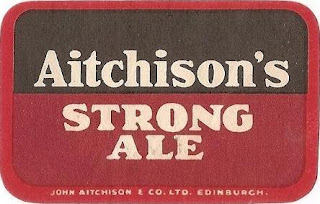See if you can spot them:
"EDINBURGH ALE. While London bears the palm of superiority in the art of porter-brewing, Edinburgh challenges all the world to compete with it in the manufacture of ale. In the making of this luxurious beverage, it has, for a considerable period of years, had no rival, unless we allow, what is perhaps correct, that the brewers of Leith, Prestonpans, and Linlithgow, and some other small towns, are equally entitled to hold up the superiority of their liquors ; nevertheless, the whole fall under the designation of Edinburgh ale. This ale differs entirely, in body, flavour, appearance, and character, from the English ales. It is as clear as amber, and of the same colour; soft and delicious in taste; so strong, that a few glasses produce a slight intoxication, or inclination to sleep ; and has a thin creamy top. It is exceedingly difficult to keep, and is easily affected by atmospheric phenomena, although kept in casks in a close cellar, and generally turns hard or sourish after being kept more than a season. It is always used in Edinburgh in glass quart bottles —never in draught; and, when diluted with water, forms an agreeable table beer. It has been occasionally alleged, from the intoxicating qualities of Edinburgh ale, that it is mixed with cocculus indicus, or some other poisonous ingredient; but this is, without doubt, an idle fallacy, the liquor being simply the strength of malt and hops. It is used only in moderate quantities, being quaffed from long tapering glasses made for the purpose, and cannot be indulged in so freely as porter, to which it bears no other resemblance than it is made from nearly the same materials, differently prepared. The quantity of strong beer or ale made in Scotland annually amounts to about 110,000 barrels, upwards of 3000 of which are exported ; the chief export being to London. About 130,000 barrels of table beer are also annually manufactured, besides an immense quantity of small beer— a species of light, cheap, frothy liquid, in great domestic request in Scotland, and which, from its resemblance, in some respects, to ginger beer, might be manufactured in the English towns with every chance of success."
"Chambers's Edinburgh journal, Volume 1", 1833, pages 246 - 247.
First, the term Edinburgh Ale was used to describe not just beer brewed in Edinburgh itself, but in some other areas of Scotland. Leith is, of course, basically a suburb of Edinburgh. Prestonpans is a little to the East along the coast of the Firth of Forth. Linlithgow is about 15 miles due West of Edinburgh.
Then there's quite a nice description of the beer itself. Amber-coloured, clear, soft and dead strong. They brewing records certainly confirm the latter. And the colour, as everything was 100% pale malt. Oh, and it had a thin head. And was served in long, thin glasses.
Just been having a look at William Younger's records from the early 1830's. You know what's really striking about them? Really short boil times. Often just an hour, with the odd one as long as an hour and a half. That tallies with the description we saw a few days ago, saying Scottish brewers liked hop aroma rather than harsh bitterness. They were also still measuring their grain in bolls rather than quarters. Despite the boll having been officially abolished with the Act of Union in 1707. I should really extract all the information from the 1830's logs properly. Another job to add to the list.
Perversely, Scottish beer was almost all bottled at the start of the 19th century but had become predominately draught by the end. It's usually the other way around. I've no real explanation. Maybe it's because it didn't keep long in casks. Remember that the breweries didn't bottle beer themselves. That was done by publicans and grocers.
I'm surprised by the poor keeping qualities of Edinburgh Ale. It would start to turn after just three months in the cask. That's not long at all. Adverts for Pale Ale from later in the century guarantee that it will last at least 12 months in the cask, if unbroached. Given its strength, you'd expect Edinburgh Ale to be more robust.
I'm not sure which year those production figures are from. 110,000 barrels of Strong Beer is right for 1829. But that year the production of Table Beer was much greater than 130,000 barrels: it was 230,000 barrels. Perhaps that includes the Small Beer mentioned. Though Small Beer had ceased to exist as a separate tax category in 1802. Those 110,000 barrels aren't a huge amount. Several of the large London breweries produced more each year.
If that Scottish Small Beer resembled ginger beer, then it couldn't have been very alcoholic. More like a soft drink.












































































2 comments:
I'm guessing (always dangerous) that the relatively poor keeping time was down to Edinburgh Ale still conforming to the 17th and 18th century idea of an "ale", ie comparatively lightly hopped. Any comparisons on hop quantities per quarter (boll?) of malt versus Burton Ale and pale ale?
Martyn, in 1831, Willaim Younger's hopping rates were pretty low - around 5 lbs per quarter. That increased as the century progressed.
In 1847 (the first year I've got a Pale Ale of theirs), the weak Shilling Ales got 5 lbs per quarter, the strong Shilling Ales 10 lbs and the Pale Ale 20 lbs.
I suspect another problem could be the low attenuation. In the 1840's, Youngers Shilling Ales had 50-60% attenuation. Still lots of food left for any lurking bugs.
The earliest Burton beers I have are Truman's from 1877. The Burton Ales have between 5.5 lbs per quarter and 12, the Pale Ales around 20.
I'll be posting more (much more) detailed comparisons when I've finished assembling all the data.
Post a Comment